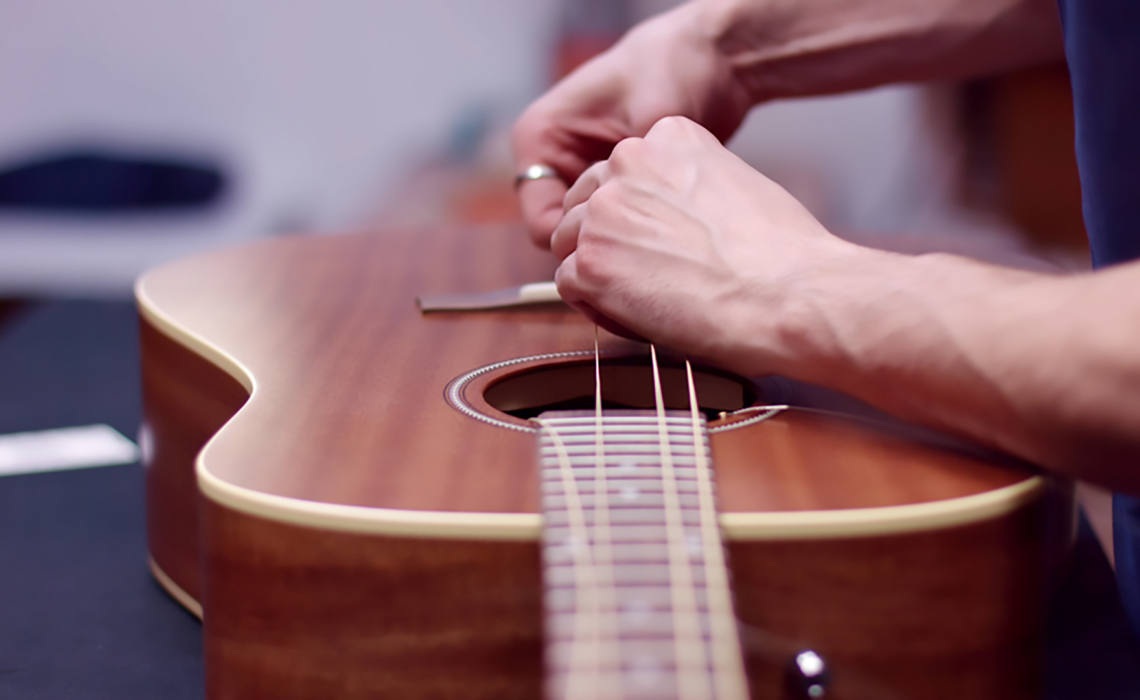
Changing the strings on your acoustic guitar is essential for keeping your instrument sounding its best. Over time, strings lose their brightness, stretch out, and can even become difficult to tune. Even if they’re not broken, how to change your acoustic guitar strings regularly ensures better tone, playability, and tuning stability.
In this guide, we’ll walk you through how to change your acoustic guitar strings properly and show you how tools like the Roadie tuner can make the process much easier.
What You Need to Change Your Guitar Strings
Before you begin, gather the following tools:
- A pack of new acoustic guitar strings (check if your guitar needs steel or nylon strings)
- Bridge pin puller (for removing bridge pins)
- Lemon oil (for cleaning the fretboard)
- Guitar polish and cloth (for a clean finish)
- String winder (to speed up the process) or use Roadie 3 to string your guitar with precision and ease.
- Wire cutters (to trim excess string)
You can tune and restring your guitar with a Roadie 3, making the process faster and more precise.
Step-by-Step Guide to Changing Acoustic Guitar Strings
Step 1: Remove the Old Strings
- Loosen each string by turning the tuning pegs counterclockwise until the string is slack.
- If you have a Roadie tuner, use its motorized winding feature to speed up this process.
- Once loose, unwind the strings from the tuning pegs and remove them.
- Use a bridge pin puller to carefully remove the bridge pins, then pull the strings out of the bridge.
Step 2: Clean Your Guitar
- With the strings removed, wipe down the fretboard with a soft cloth to remove dirt and oil buildup.
- Apply a small amount of lemon oil to condition the fretboard (only for rosewood or ebony fretboards).
- Use a microfiber cloth and guitar polish to clean the body of your guitar.
Step 3: Install the New Strings
- Find the ball end of the new string and insert it into the corresponding hole in the bridge.
- Insert the bridge pin back into the hole, making sure the groove in the pin faces forward.
- Gently pull on the string to ensure it’s properly seated in the bridge.
- Repeat this process for all six strings.
Step 4: Attach the Strings to the Tuning Pegs
- Draw each string over the saddle and nut, then thread it through the tuning peg hole.
- Leave some slack and begin winding the string around the peg.
- Use a Roadie tuner to automatically wind each string for even tension and better tuning stability.
Step 5: Tune and Stretch the Strings
- Use your Roadie tuner to accurately tune each string to standard tuning (E-A-D-G-B-e) or any custom tuning you prefer.
- Gently pull and stretch each string a few times to help it settle.
- Retune using the Roadie tuner, as strings will continue to stretch slightly.
- Trim any excess string at the tuning pegs using wire cutters.
Here’s a Video If You’re a Visual Learner
If you prefer to see the restringing process in action, check out this step-by-step video tutorial:
Watching someone change their strings can make it easier to follow along, especially if this is your first time restringing your guitar.
Final Tips for Keeping Your Acoustic Guitar in Great Shape
- Change your strings regularly—every 2 to 4 weeks if you play often.
- Use the right string gauge—lighter strings are easier to play, while heavier ones produce a fuller sound.
- Keep your guitar in tune—using a Roadie tuner ensures quick and precise tuning every time.
- Clean your guitar during each string change to keep it in excellent condition.
By following these steps and using a Roadie 3 to assist with winding and tuning, you’ll keep your acoustic guitar sounding fresh and performing at its best.

